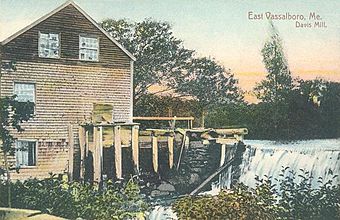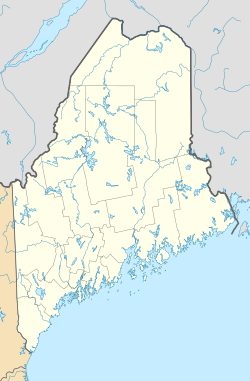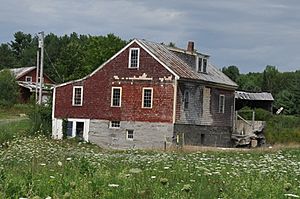East Vassalboro Grist and Saw Mill facts for kids
Quick facts for kids |
|
|
East Vassalboro Grist and Saw Mill
|
|

1910 postcard view of an East Vassalboro mill
|
|
| Location | ME 32, East Vassalboro, Maine |
|---|---|
| Area | 1 acre (0.40 ha) |
| Built | 1798 |
| Built by | Getchell, John; Dow, Jabez |
| NRHP reference No. | 82000752 |
| Added to NRHP | January 28, 1982 |
The East Vassalboro Grist and Saw Mill is a really old and important mill complex in East Vassalboro, Maine. It started way back in the late 1700s! This mill is one of the oldest places in Maine that used water power to grind grain and cut wood. It still has its original equipment for both grist (grinding grain) and lumber (cutting wood). Because it's so special, it was added to the National Register of Historic Places in 1982.
Contents
Discover the Historic East Vassalboro Mill
The East Vassalboro Mill is located near the northern end of the village of East Vassalboro. This village sits at the mouth of Outlet Stream. This stream flows out of China Lake. The mill stands on the east side of Route 32.
How the Mill Works
The mill has two main buildings. They are on either side of a special channel called a mill race. Water from this race powers both mills. A mill race is like a small canal. It directs water from a river or stream to turn a water wheel. This wheel then powers the machinery inside the mill.
The Old Sawmill Building
The sawmill is a 1-1/2 story building. It is made of strong timber frames. Some of its wooden beams are 1 foot wide and 57 feet long! It has a metal roof shaped like a gable. Two smaller additions were built on its north and east sides.
This sawmill was first built in 1798 by John Getchell. It was originally located about 300 yards upstream. In 1805, Jabez Dow moved it to its current spot. Around that time, he also built the grist mill.
The Grist Mill Building
The grist mill is also a 1-1/2 story building. It has a timber frame and a gabled roof. There is a small shed extension on its north side. The mill sits on a strong foundation of cut granite stones. You can see these stones on the west side. They have openings for a doorway and windows.
Who Owned the Mills?
In the mid-1800s, the Butterfield family owned these mills. Later, in 1870, the Vassalboro Woolen Company bought them. In 1912, Louis Masse purchased the mills. His family continued to operate them for a large part of the 20th century.




